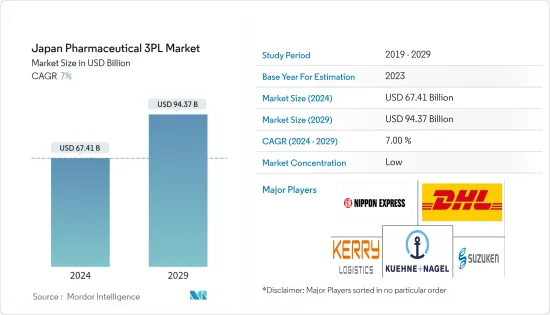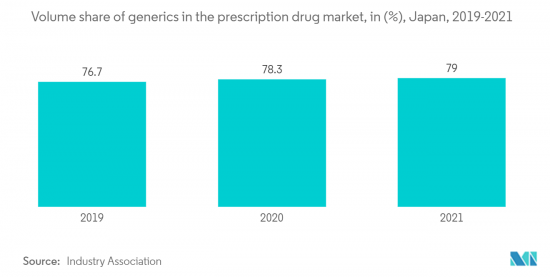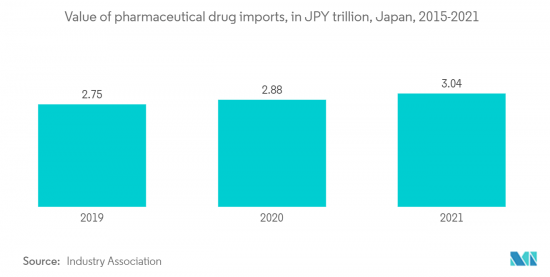PUBLISHER: Mordor Intelligence | PRODUCT CODE: 1430597

PUBLISHER: Mordor Intelligence | PRODUCT CODE: 1430597
Japan Pharmaceutical 3PL - Market Share Analysis, Industry Trends & Statistics, Growth Forecasts (2024 - 2029)
The Japan Pharmaceutical 3PL Market size is estimated at USD 67.41 billion in 2024, and is expected to reach USD 94.37 billion by 2029, growing at a CAGR of 7% during the forecast period (2024-2029).

Key Highlights
- The pharmaceutical industry's third-party logistics market is growing because more and more people are willing to use online delivery services. This trend has led to a rise in demand for third-party logistics solutions. Japan has been the leading force in the pharmaceutical third-party logistics market, with the government providing incentives. The Japanese Pharmaceutical and Medical Devices Agency, in partnership with the Japanese Ministry of Health, Labour, and Welfare and drug companies, created a platform for online information exchange and patient consultation services.
- The demand for temperature-controlled logistics services to ship biologics across international borders and the expansion of biopharmaceutical companies' distribution networks to boost sales are fueling market expansion. It serves as motivation. Pharmaceutical logistics organizations have noticed a considerable increase in the use of automated storage and retrieval systems in emerging nations. By limiting supply disruptions and giving priority to crucial treatments, major market actors played a significant role in the fight against COVID-19.
- For example, Nippon Express has WHO Standard GDP Certification for the East Japan Pharmaceutical Center in Kuki, Saitama Prefecture. This is because they focus on storage and transit with two temperature zones to meet the demand for high-quality logistics. The center has WHO (World Health Organization) standard GDP certification for storing and transporting medications in two temperature zones (room temperature: 15-25°C, cold storage: 2-8°C).
Japan Pharmaceutical 3PL Market Trends
Generics drugs market growing in the country
The generic drug market in Japan is growing at a rapid pace, with more and more drug companies starting up in the past few years. Japanese generics are now one of the fastest-growing segments in the pharmaceutical industry, as rising life expectancy and an aging population put pressure on existing suppliers to find new solutions. Japan is a country known for its high technology and strong market competition. It also has one of the highest healthcare expenditures per capita in the world.
Comparing Japan to other developed markets like the US and EU, generic medicine penetration has always been lower in Japan. Since the turn of the century, however, the number of people taking generic drugs has grown quickly due to a change in government policy.
In response to the country's aging population and the rising cost of branded drugs, the government passed a law to cut medical spending and move money from low-cost generics to innovative products. By September 2020, the government set a goal of 80% generic medicine penetration, although it only achieved roughly 2% of that aim. In the Japanese prescription medicine market as of September 2021, generics held a share of roughly 79%.
Generics were a good market for businesses and individuals who wanted brand-name drugs at cheap prices. When making generic versions of more expensive brands, pharmaceutical companies tried to make them taste, look, smell, and even feel like the more expensive brands. These copycat versions were named after the most popular drug names from major manufacturers, so customers could hardly tell the difference between a generic and its branded counterpart.

Pharmaceutical imports growing in the country
Japan is an export market for American pharmaceuticals and the third-largest pharmaceutical market in the world. The healthcare sector was marketed by the Government of Japan ("GOJ") since 2013 as a growth driver under the nation's economic revival and growth strategy. The pharmaceutical industry in Japan, along with the healthcare industry, has recently attracted new interest. This increased interest in Japan's healthcare industry is partly due to the COVID-19 pandemic, which highlighted the value of innovative healthcare goods. The requirement to strengthen Japan's drug discovery environment is a significant additional factor driving interest in the country's pharmaceutical industry. About 20% of all pharmaceutical imports into Japan are made up of American products, including those produced locally by American businesses and those that have been licensed to Japanese producers.
Through 2025, the pharmaceuticals market in Japan is expected to contract at a rate of 0.2-1.2% per year, while the global pharmaceuticals market is anticipated to expand at a rate of 4.4%. A concomitant fall in Japan's off-patent drug market is one of the factors contributing to the expected decline in the country's pharmaceutical sector. However, it is anticipated that the Japanese market for patented drugs, where U.S. corporations' goods shine, will continue to expand throughout this time.

Japan Pharmaceutical 3PL Industry Overview
The pharmaceutical third-party logistics (3PL) market in Japan is very competitive. Given the sensitivity of the items being transported, pharmaceutical logistics demands a high degree of specialization, regulatory approvals, cutting-edge technology, greater network coverage, and a great deal of expertise; hence, the industry has comparably fewer competitors. DHL Logistics, Nippon Express, Kuehne + Nagel, and Kerry Logistics are some of the market's top companies. These firms are gaining a competitive edge by providing options for quicker shipping and warehousing with specialized storage facilities.
Additional Benefits:
- The market estimate (ME) sheet in Excel format
- 3 months of analyst support
TABLE OF CONTENTS
1 INTRODUCTION
- 1.1 Study Assumptions and Market Definition
- 1.2 Scope of the Market
2 RESEARCH METHODOLOGY
3 EXECUTIVE SUMMARY
4 MARKET INSIGHTS
- 4.1 Market Overview
- 4.2 Current Market Scenario
- 4.3 Government Initiatives and Regulations
- 4.4 Technological Trends
- 4.5 Industry Supply Chain/Value Chain Analysis
- 4.6 Investment Scenarios
- 4.7 Pharmaceutical E-Commerce Market in Japan
- 4.8 Spotlight on packaging of pharmaceuticals (global and regional trends)
- 4.9 Impact of COVID-19 on market (including short-term and long-term effects on the market as well as the economy)
5 MARKET DYNAMICS
- 5.1 Drivers
- 5.2 Restraints
- 5.3 Opportunities
- 5.4 Industry Attractiveness - Porter's Five Forces Analysis
- 5.4.1 Bargaining Power of Suppliers
- 5.4.2 Bargaining Power of Consumers
- 5.4.3 Threat of New Entrants
- 5.4.4 Threat of Substitutes
- 5.4.5 Intensity of Competitive Rivalry
6 MARKET SEGMENTATION
- 6.1 By Service
- 6.1.1 Domestic Transportation Management
- 6.1.2 International Transportation Management
- 6.1.3 Value-added Warehousing and Distribution
- 6.2 By Temperature Control
- 6.2.1 Controlled/Cold Chain Logistics
- 6.2.2 Non-controlled/Non-Cold Chain Logistics
7 COMPETITIVE LANDSCAPE
- 7.1 Market Concentration Overview
- 7.2 Mergers & Acquisitions
- 7.3 Company Profiles
- 7.3.1 Suzuken Group
- 7.3.2 Nippon Express
- 7.3.3 DHL Logistics
- 7.3.4 Kuehne + Nagel
- 7.3.5 Kerry Logistics
- 7.3.6 Mitsubishi Logistics
- 7.3.7 Ceva Logistics
- 7.3.8 DB Schenker
- 7.3.9 FedEx
- 7.3.10 Yusen Logistics*
8 MARKET OPPORTUNITIES AND FUTURE TRENDS
9 APPENDIX
- 9.1 Macroeconomic Indicators (GDP Distribution, by Activity)
- 9.2 Economic Statistics - Transport and Storage Sector Contribution to the Economy
- 9.3 External Trade Statistics - Exports and Imports by Product and by Country of Destination/Origin




